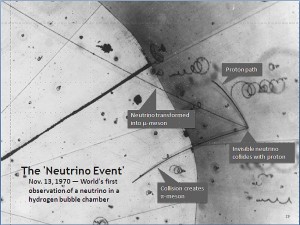Neutrinos may not be neutral after all!
Do neutrinos affect radioactive decay? That's what new research at Purdue seems to suggest. When researchers at Purdue were looking for a reliable way to generate random numbers, they thought they were smart to use radioactive decay - after all the rate of decay was a known constant (for a given material) but the decay of any particular atom was truly random. But what they discovered may have huge implications for the Standard Model, for physics and for cosmology.
As the researchers pored through published data on specific isotopes, they found disagreement in the measured decay rates – odd for supposed physical constants. Checking data collected at Brookhaven National Laboratory on Long Island and the Federal Physical and Technical Institute in Germany, they came across something even more surprising: long-term observation of the decay rate of silicon-32 and radium-226 seemed to show a small seasonal variation. The decay rate was ever so slightly faster in winter than in summer.In addition, during a solar flare event in Dec 2006, a Purdue researcher, observing day in manganese-54, noticed that the decay rate began to drop almost 36 hours before the flare event
 became visible on earth. In a series of published papers, the Purdue team showed that the observed variations in decay rates were highly unlikely to have come from environmental influences on the detection systems.
Their findings strengthened the argument that the strange swings in decay rates were caused by neutrinos from the sun. The decay rates dropped as the Earth came closer to the sun (where it would be exposed to more neutrinos) and rose as the Earth moved farther away.
So there was good reason to suspect the sun, but could it be proven?
Enter Peter Sturrock, Stanford professor emeritus of applied physics and an expert on the inner workings of the sun. Sturrock knew from his experience that the observed neutrino intensity varies on a regular basis as the sun revolves and shows a different face to the Earth. He suggested that Purdue: Look for evidence that the changes in radioactive decay on Earth vary with the rotation of the sun.
Looking again at the decay data from the Brookhaven lab, the researchers found a recurring pattern of 33 days, which differed from the observed solar rotation period of about 28 days. They explain this by suggesting that the core of the sun – where nuclear reactions produce neutrinos – spins more slowly than the surface.
The evidence points toward a conclusion that emissions form the sun are directly influencing radioactive isotopes on Earth.
However, no one knows how neutrinos could interact with radioactive materials to change their rate of decay. This result holds promise in many ways: as an early warning system for Solar Flares; as an avenue for new research on neutrinos; or as the first inking of even stranger new particles. “It would have to be something we don’t know about, an unknown particle that is also emitted by the sun and has this effect, and that would be even more remarkable,” Sturrock said.
H/T: io9 and Symmetry Magazine
became visible on earth. In a series of published papers, the Purdue team showed that the observed variations in decay rates were highly unlikely to have come from environmental influences on the detection systems.
Their findings strengthened the argument that the strange swings in decay rates were caused by neutrinos from the sun. The decay rates dropped as the Earth came closer to the sun (where it would be exposed to more neutrinos) and rose as the Earth moved farther away.
So there was good reason to suspect the sun, but could it be proven?
Enter Peter Sturrock, Stanford professor emeritus of applied physics and an expert on the inner workings of the sun. Sturrock knew from his experience that the observed neutrino intensity varies on a regular basis as the sun revolves and shows a different face to the Earth. He suggested that Purdue: Look for evidence that the changes in radioactive decay on Earth vary with the rotation of the sun.
Looking again at the decay data from the Brookhaven lab, the researchers found a recurring pattern of 33 days, which differed from the observed solar rotation period of about 28 days. They explain this by suggesting that the core of the sun – where nuclear reactions produce neutrinos – spins more slowly than the surface.
The evidence points toward a conclusion that emissions form the sun are directly influencing radioactive isotopes on Earth.
However, no one knows how neutrinos could interact with radioactive materials to change their rate of decay. This result holds promise in many ways: as an early warning system for Solar Flares; as an avenue for new research on neutrinos; or as the first inking of even stranger new particles. “It would have to be something we don’t know about, an unknown particle that is also emitted by the sun and has this effect, and that would be even more remarkable,” Sturrock said.
H/T: io9 and Symmetry Magazine
